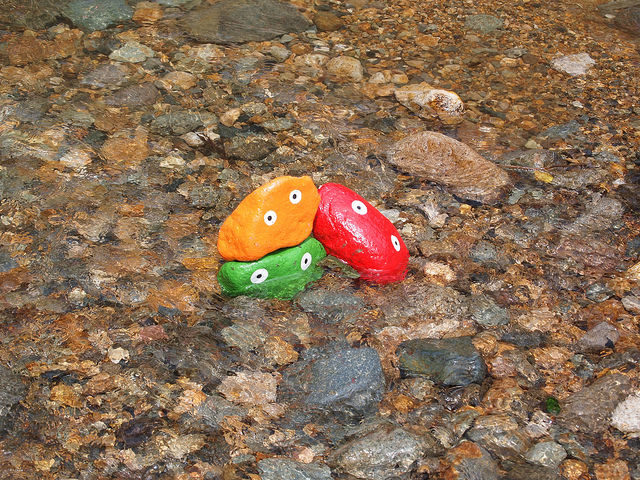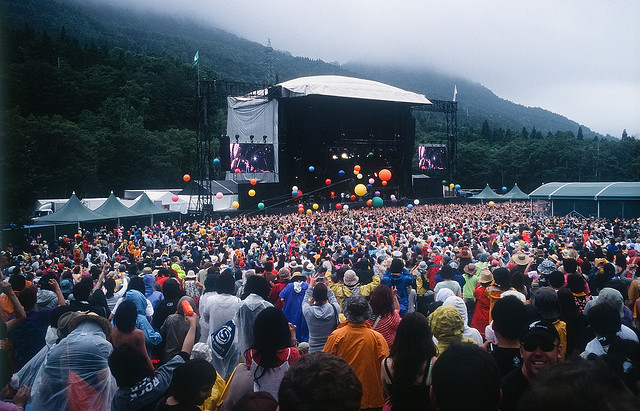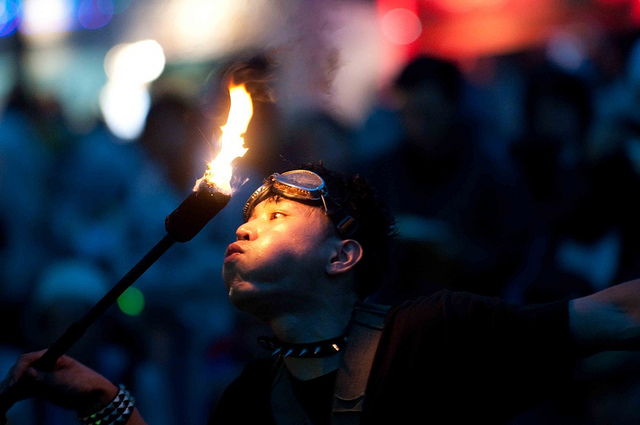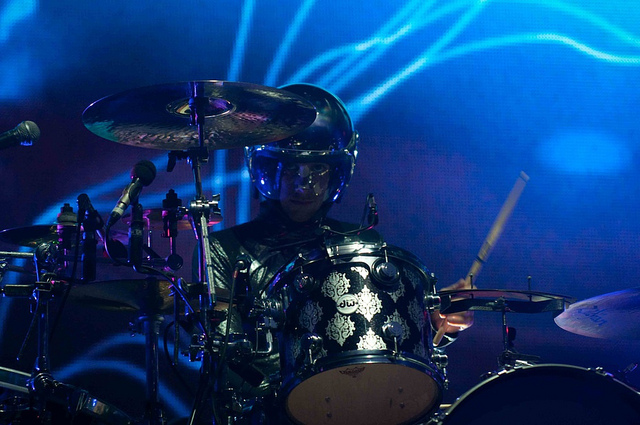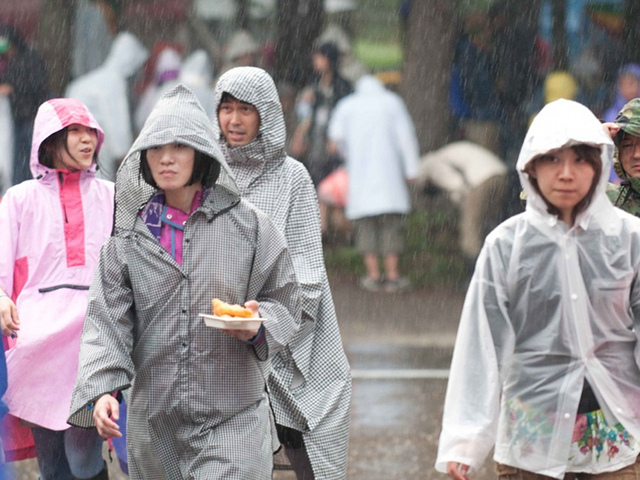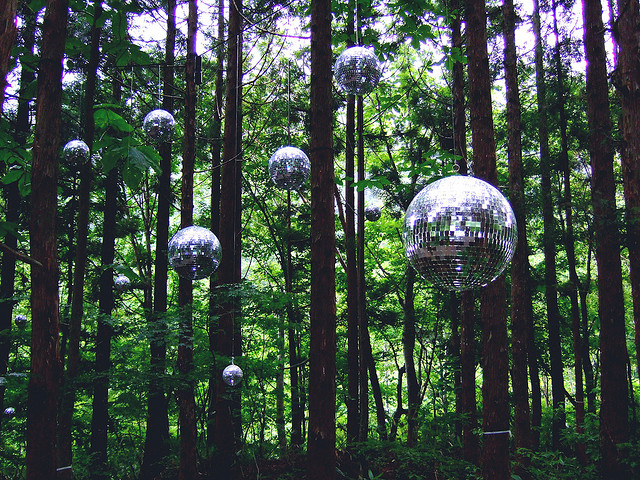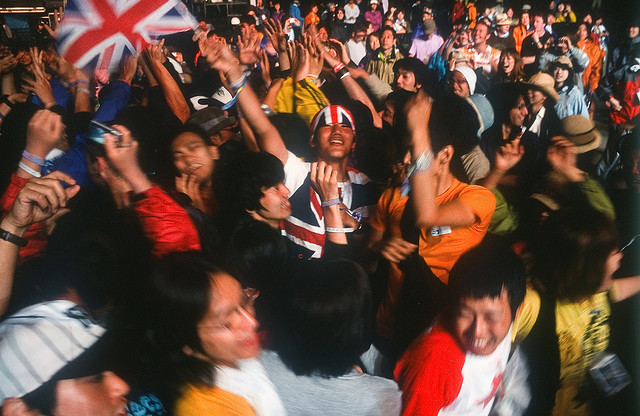Fuji Rock Festival
Every summer thousands of Japan’s young people head to the mountains to gorge themselves on a lavish helping of music. The three-day-long Fuji Rock Festival plays host to some of the most famous bands from across the world, as well as local and alternative performers. It’s one big non-stop party, a world away from the everyday grind in the cities.
The venue for the festival is Naeba Ski Resort in Niigata Prefecture. Around ten stages are dotted throughout the forest on the mountain slopes, the largest of which can fit 50,000 spectators. This is where the biggest names perform – in recent years the festival has played host to Oasis, Coldplay, Arctic Monkeys, The Cure, Ocean Colour Scene, Red Hot Chili Peppers and Mogwai among many others. But if your taste is less mainstream, there’s no need to despair – each stage has its own ethos, and there’s everything from folk music to punk rock and J-pop.
The ‘White Stage’, in a clearing surrounded by trees, has a capacity of over 10,000, and is declared to be genre-free, so it provides entertainment for a broad range of tastes. The ‘Red Marquee’, the festival’s only under-cover venue, can fit 5,000 revellers. It hosts bands all day and evening, and then turns into an all-night rave featuring dance acts and top DJs until five in the morning. The ‘Orange Court’ can also fit 5,000, but features jazz and world music. The last of the big stages is the ‘Field of Heaven’, where candles and lighting effects are used to create a magical atmosphere.
Hidden amongst the trees is the small ‘Mokudo Tei’ stage, where you can savour both music and the forest atmosphere. The ‘Rookie a Go-Go’ stage has a capacity of 1,000, and is where wannabe stars try to impress. One lucky band will get the chance to perform on the main stage next year, based on a public vote and a further round of auditions. Several of Japan’s present-day stars launched their careers on the back of this contest.
If you want to escape the big crowds for a bit, ride the Dragondola cable car to the top of the mountain. During the five and a half kilometre ride, you are treated to a birds-eye-view of the whole festival. You arrive at a point over four hundred metres higher up, from where you get a panoramic view of blue sky and green mountains. Two more stages are up here – ‘Day Dreaming’ and ‘Silent Breeze’, both of which have a quiet and relaxed atmosphere.
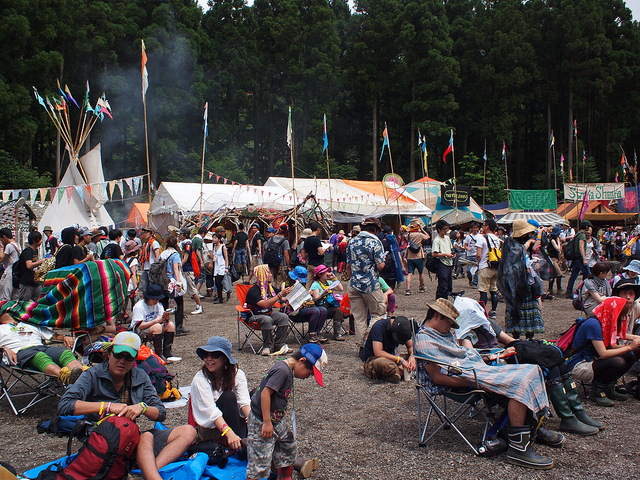
The Field of Heaven at Fuji Rock 2010. These revellers seem to be recharging in preparation for more merrymaking later in the day. This is one of the more alternative venues, and it has a somewhat mysterious aura, especially after dark.
‘Gypsy Avalon’ aims to be chilled out and alternative, and is where the most right-on gather. Bands perform on a small stage, but here you’ll also find jugglers and fire eaters, and stalls offering everything from massages to a flea market. This is where the serious side of the festival happens too – at the NGO Village, international and Japanese groups are there to tell you about the issues of the day – from society’s problems to world peace and saving the planet. You can go to a talk, join in a workshop, or you could just chill out and feel virtuous while soaking up the vibe.
Several other venues are scattered throughout the festival, and sometimes you will see musicians putting on impromptu performances anywhere they can find a space. If you want to have a go yourself, you can join in the drumming at the ‘Stoned Circle’ – prior experience is not a requirement. In-between the stages, you’ll come across hammocks strung up between the trees, randomly-placed sculptures, and people dressed in every type of costume you could imagine.
In the evenings ‘Cinema Fuji’ puts on films for anyone who overdosed on music during the day. But if you’ve still got energy left after the main stages close, head to the ‘Palace of Wonder’. This is the alterative place to party until dawn, where gigantic ‘art objects’ and flashing lights help to create a surreal atmosphere. Don’t be surprised to see an insect sculpted from a car, a motorbike crossing a tightrope, or giant illuminated mushrooms.
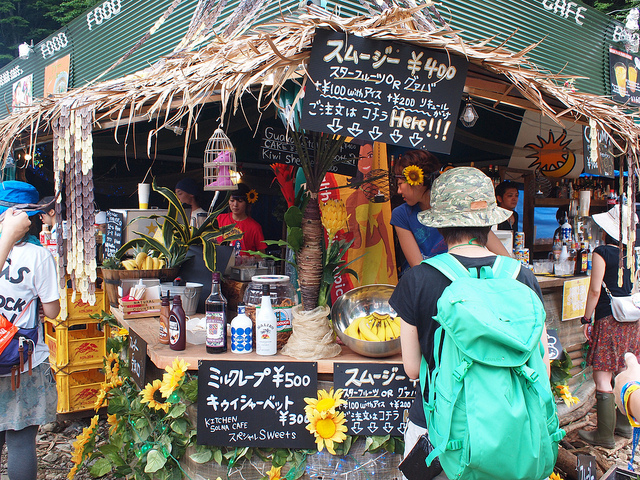
One of the many food and drink stalls. This one sells star fruit or guava smoothies, but you have to pay an extra ¥100 for ice, and ¥200 extra if you want an alcoholic one. The food on offer includes Mille Crepe and Kiwi Sherbet. Just reading the signs is making my mouth water.
Besides having the biggest selection of top-rated artists to be found anywhere in Japan, the festival provides a unique opportunity to take a break from the real world, and to share a love of music with some of Japan’s most easygoing and amiable young people. Fuji Rock is reputed to be the most good-humoured big festival anywhere in the world, and it’s perhaps the easiest place in the whole of Japan to make new friends – so even if you go on your own it won’t be hard to find people to share the party with. It also attracts some of Japan’s most imaginative and creative dressers – you might even see someone dressed as a pink love-heart.
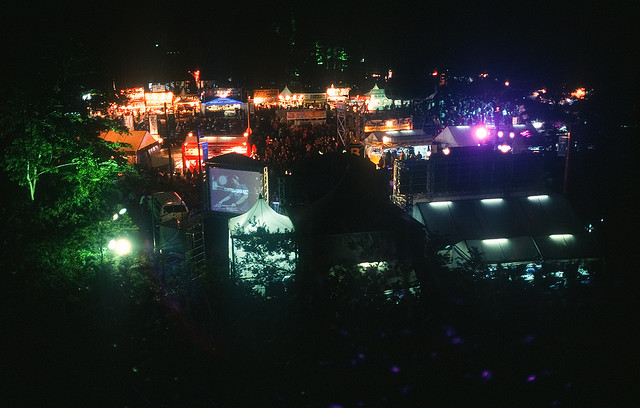
The festival keeps on going long after it gets dark. Most of the site closes down at eleven, but some venues keep going all night.
As you move between stages, you pass through beautiful forest and cross crystal-clear mountain streams. It’s a couple of kilometres from one end of the hilly site to the other, but it’s such a wonderful environment that it’s well worth a little exertion. Despite the huge crowds, the festival has a peaceful and relaxed atmosphere. It also aims to be the cleanest festival in the world, and probably succeeds. A lot of effort goes into recycling, there’s very little litter, and even the toilets are clean! The organisers go out their way to make the festival child-friendly, and under-twelves get in for free. There’s a play area with a free merry-go-round hidden in the forest, and kids can explore their artistic talents at a painting workshop, or have a go at making their own musical instrument.
The cool mountain air makes a welcome change from Japan’s hot and muggy summer, but be prepared for sudden changes in the weather. Rain is very common – so don’t be surprised if you end up wet and muddy. If you were hoping to get a view of Mount Fuji, you’re going to be disappointed. The festival’s name comes from its original venue, but after only one year at the base of Mount Fuji, and another on Tokyo’s waterfront, the festival moved to its present location. It’s been there since 1999, and looks set to stay, but the original name has stuck.
Every year the festival is held at the end of July, starting on a Thursday and ending in the early hours of Monday morning. Over 200 performers and well over 100,000 revellers join in the party. Each day the site opens at 9:00am, and the stages host non-stop music from eleven in the morning until eleven at night. Tickets go on sale in March, and cost about ¥17,000 for one day, or ¥40,000 for the whole festival. You can buy them at Lawson or Family Mart convenience stores in Japan, or online at GAN-BAN. There are plenty of places to buy food and drink – the festival is famous for its huge range of foods from around the world – but expect to pay a big premium for the convenience of buying your refreshments on-site.
Fuji Rock’s most passionate devotees insist that the only proper accommodation is a tent in the campground – and around 17,000 festival-goers choose this option every year. As the festival site is also a ski resort, there’s a profusion of hotels, ryokan and minshuku within walking distance. This accommodation is so popular that you need to book well in advance, and much of it is allocated by lottery. (See the official English website for details.)
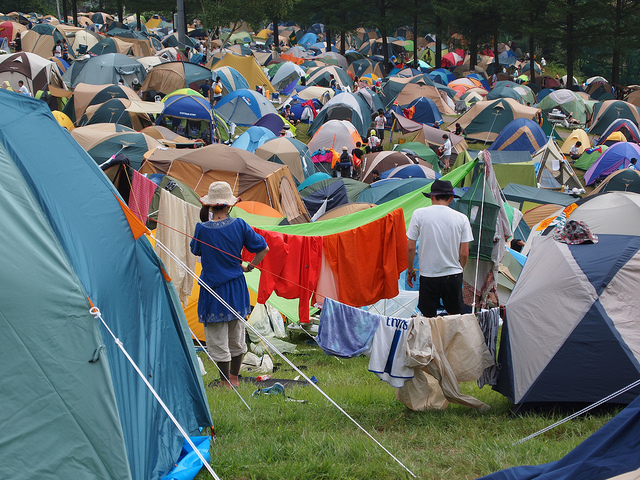
Just a small part of the crowded campsite, which functions as a golf course for most of the year. The putting greens are strictly off limits, and there aren’t many other flat spots, so most people have to pitch their tents on the hillside. On the plus side, the campsite has its own hot spring baths, and is just a few minutes walk from the festival site.
If you can’t get booked in Naeba, a free shuttle bus connects the festival site to the nearby ski resorts of Tashiro, Asagai and Mitsumata, and to the town of Yuzawa about forty minutes away, all of which have their own accommodation options. The bus runs until 2am, so there’s no problem getting back to your accommodation at night. Yuzawa is also the location of Echigo-Yuzawa Station, which is an hour and a quarter from Tokyo by shinkansen (¥6,490 each way), so you could even commute from Tokyo. If you prefer to drive, on site parking is ¥3,000 per day, but needs to be booked when you buy your ticket. The official website lists a range of packages that include festival entry, transport (train, coach or plane) and/or accommodation.
BOAT RACE International Robot Exhibition


